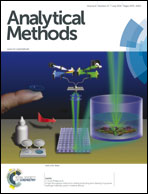Discrimination of Chinese patent medicines using near-infrared spectroscopy and principal component accumulation method
Abstract
The discrimination of pharmaceutical products has been an important task in pharmaceutical industry and for pharmaceutical safety. In this study, the principal component accumulation (PCAcc) method was investigated for the discrimination of Chinese patent medicines. In the PCAcc method, an accumulation strategy is utilized to combine the classification information contained in multiple PC subspaces by using a rotation, a projection and a summation operation. To improve the performance of classification, continuous wavelet transform is applied as the pretreatment method to eliminate the background. The results show that, among the 12 classes of Chinese patent medicines, 8 classes are correctly classified, and a total of ten samples are misclassified for the other four classes. Compared with the results obtained by principal component analysis, radial basis function artificial neural network and partial least squares discriminant analysis, PCAcc produces the best classification.


 Please wait while we load your content...
Please wait while we load your content...